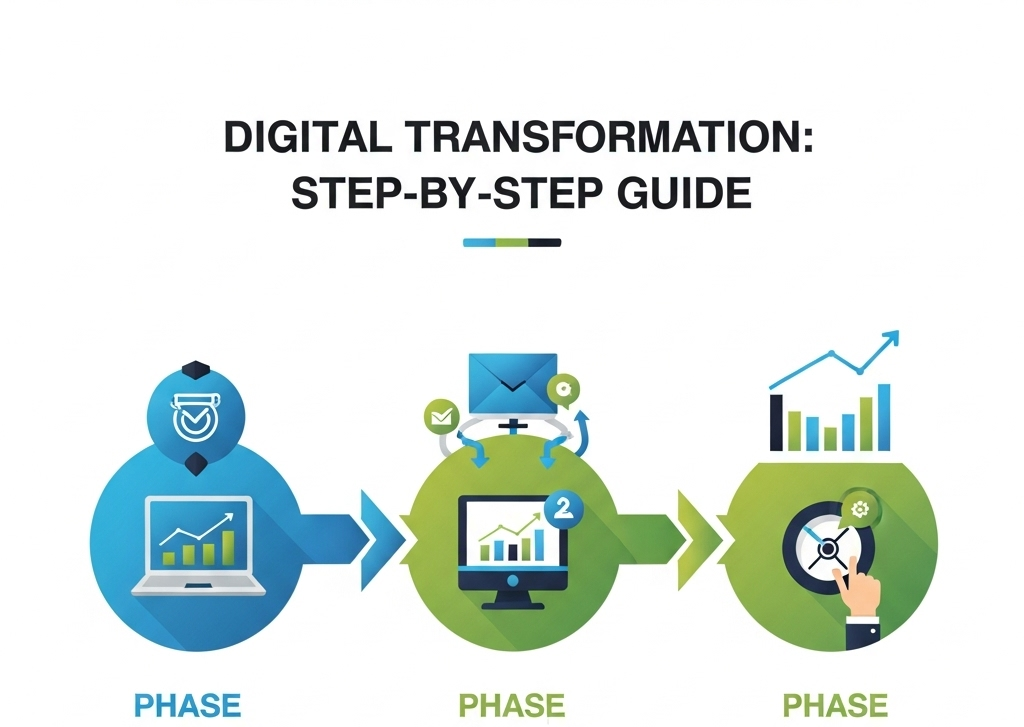
How Businesses Can Start Digital Transformation: Step by Step Guide
Instead of a generic checklist, here is a strategic, phase-based guide designed to overcome common transformation failures, which often result from a lack of vision, insufficient change management, and a poor understanding of technology’s true purpose. This framework focuses on building a resilient, adaptable culture from the ground up, ensuring technology serves business goals rather than the other way around.
Phase 1: The ‘Why’—Framing the vision and gaining commitment
- Define a compelling purpose, not just a plan. Before touching any technology, clearly articulate the core business problem you are solving and the value it creates for customers and employees. For example, instead of “We need to adopt AI,” the vision is, “We will leverage AI to offer hyper-personalized customer support, reducing resolution times and boosting satisfaction.”
- Build an interdisciplinary “Transformation Council.” Form a steering committee with executives and representatives from every department, not just IT. This ensures that all functions, from sales and marketing to HR and operations, have a voice and feel ownership over the process. A single-department approach is a common failure point.
- Secure top-down and bottom-up buy-in. Use the council to create a unified narrative around the transformation’s purpose. Conduct workshops to show employees how digital tools will improve their daily work, not just replace it. Actively listen to employee concerns and celebrate early wins to build momentum and trust.
Phase 2: The ‘What’—Piloting, learning, and strategizing
- Prioritize quick wins with strategic value. Use an impact-vs-effort matrix to identify pilot projects that deliver tangible, near-term results. This proves the concept, builds internal confidence, and provides invaluable lessons before investing in a full-scale rollout.
- Create an adaptable, modular roadmap. Think of your roadmap not as a rigid plan, but as a series of connected modular projects. Prioritize initiatives based on a clear understanding of what technologies will solve specific pain points. For example, a quick win might be automating repetitive admin tasks with an AI tool, which can later be integrated with a new CRM system.
- Identify critical capability and skill gaps. Assess what digital skills your current workforce lacks through surveys and performance reviews. Build a plan that includes upskilling existing staff with data literacy and AI-ready training, while also defining new roles or partnerships for specialized expertise.
Phase 3: The ‘How’—Building, deploying, and iterating
- Deploy technology with a human-centric approach. Implement new technologies incrementally, starting with small pilot groups to test, gather feedback, and refine. This minimizes disruption and allows your organization to adjust the tech and training based on real user experiences.
- Establish a continuous learning loop. Digital transformation is never “done”. Implement systems to continuously track key performance indicators (KPIs) and gather employee feedback. Use this data to iterate and adjust your strategy, ensuring your business stays agile and responsive to market shifts.
- Embed governance and data ethics. Implement clear policies around how data is collected, used, and secured from the beginning. With AI and automation, this is crucial for building customer trust and managing cybersecurity risks. A dedicated governance body can oversee compliance and ethical considerations
